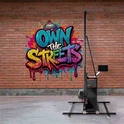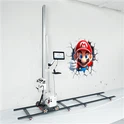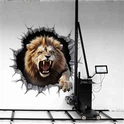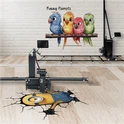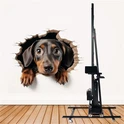Starting a wall printing business requires more than just comparing technical specifications. After nearly a decade in the industry, I've watched countless entrepreneurs make costly mistakes by focusing on the wrong metrics. This guide reveals what actually determines success in wall printing operations-from printhead selection to hidden operational costs that can make or break your business. We'll emphasize practical factors beyond the spec sheet, including reliability, efficiency, and total cost of ownership (TCO).
Printhead: Your Business's True Foundation
The printhead is the heart of any wall printer, and choosing the wrong one can cripple your operation from day one. While manufacturers love to tout resolution numbers, real-world performance depends on three critical factors: print speed, throw distance, and long-term reliability.
Why Most Printheads Fail at Wall Printing
Traditional printheads like the Epson DX10 might seem attractive due to their low cost, but here's the reality: these are discontinued models, and everything on the market is refurbished-sometimes third or fourth-hand. Users report replacing these heads every 1-3 months, creating massive hits to both uptime and profitability.
Newer options like the Epson I1600 and I3200 offer better reliability but come with a fatal flaw: limited throw distance. These heads only perform well when positioned extremely close to flat surfaces. If you're planning to work on anything beyond smooth drywall-brick, wood, or textured surfaces-you'll encounter significant issues. However, Epson-certified I1600 printheads provide stability with a 1-3 year lifespan under proper maintenance, making them suitable for high-resolution work on smooth surfaces without needing external pressure systems.
The Ricoh Advantage
The Ricoh GH2220 provides better throw distance than Epson alternatives, making it more suitable for uneven surfaces. However, it struggles with UV inks, leading to faster degradation and increased maintenance requirements. It's also underpowered for large murals, forcing operators to reduce print speeds significantly.
The Ricoh G6 stands as the current industry benchmark, addressing every major limitation:
- Industrial-grade components with superior durability
- Double the print speed of competing heads
- 20mm throw distance capability for textured surfaces
- Recirculating ink system preventing clogs and ensuring consistent pressure
- Compatibility with water-based, eco-solvent, and UV inks
Tanyu supports upgrades to I3200 or G6 options for enhanced quality, highlighting how premium printheads like the G6 reduce long-term downtime and boost profitability despite higher upfront costs. While the G6 carries the highest price tag, it's an investment in operational reliability. Consider this: replacing a cheaper printhead every three months costs more in downtime and labor than investing in quality upfront.
The Truth About "Print Ready Time" (TTP)
Manufacturers love advertising "assembly time," but this metric is deliberately misleading. What matters for your business is Time to Print (TTP)-the actual time from arriving on-site to ink hitting the wall.
Modular vs. One-Piece Systems: Real-World Differences
In the world of wall printing machines, the choice between modular (often referred to as split-body) and one-piece (integrated or fixed-frame) systems can significantly impact your business operations, from setup efficiency to portability and long-term maintenance. These designs differ fundamentally in their construction: one-piece systems feature a solid, pre-assembled frame that arrives ready-to-use, while modular systems break down into detachable components for easier handling. Drawing from industry insights, this comparison explores their advantages, disadvantages, and real-world implications, with a particular emphasis on why modular systems often shine for entrepreneurs prioritizing flexibility and mobility.
Understanding One-Piece Systems
One-piece wall printers are built as a single, cohesive unit with pre-assembled rails, motion systems, and factory calibration that remains intact during transport. This design prioritizes stability and simplicity for users who operate in consistent environments.
Advantages of One-Piece Systems
- Structural Stability and Durability: With fewer movable parts and joints, these printers experience minimal vibrations during operation, making them highly robust for high-volume printing. They're ideal for fixed workshops or permanent installations where the machine doesn't need frequent relocation.
- Quick Setup Time: Experienced operators can go from unloading to printing in under 30 minutes in standard rooms, with only an additional 10-20 minutes required for tight spaces. This efficiency stems from pre-calibration, reducing the need for on-site adjustments.
- Lower Routine Maintenance: The integrated design means fewer components to inspect or calibrate regularly, leading to less downtime and making them suitable for stable, high-output environments like hotels, museums, or corporate branding projects.
Disadvantages of One-Piece Systems
- Limited Portability: Weighing 50-80 kg or more, these units are bulky and require at least two people and a large van for transport. Moving them through narrow hallways, staircases, or elevators can be challenging, limiting their use for on-site or mobile jobs.
- Reduced Flexibility: They're less adaptable to uneven surfaces, obstacles, or irregular spaces. Repairs often involve servicing the entire unit on-site, which can be time-consuming and disruptive.
- Higher Logistical Challenges: In real-world scenarios, such as multi-location projects or jobs in remote areas, the lack of disassembly options increases transportation costs and risks damage during handling.
Understanding Modular (Split-Body) Systems
Modular wall printers, also known as split-body designs, consist of detachable modules-each typically weighing 10-25 kg-that can be assembled and disassembled on-site. This approach emphasizes versatility, making it a favorite for dynamic business models. Examples include models like the Tanyu TWF1000, which incorporates modular functionality for seamless switching between wall and floor printing without extensive reassembly.
Advantages of Modular Systems (Highlighted for Emphasis)
Modular systems excel in real-world applications where adaptability and ease of use are paramount, offering several standout benefits that can transform a wall printing business:
- Superior Portability and Mobility: One of the most compelling advantages is their lightweight, disassemblable nature, allowing a single person to transport the entire system in a small car using protective carrying bags or custom travel cases. This makes them perfect for on-site jobs in apartments, events, or hard-to-reach locations like narrow stairwells or small elevators-scenarios where one-piece systems would be impractical. For instance, the Tanyu TMP1000 features a collapsible frame and travel kit that fits in most car trunks, enabling mobile muralists to service a wider geographic area without heavy lifting.
- Enhanced Scalability And Flexibility: Startups and solo operators can begin small and expand easily, as modular printers support team growth or franchising. Tanyu adapts to unev`en surfaces and obstacles-allows for precise adjustments without relocating the whole machine. Opening up new revenue streams in diverse applications, from home décor to commercial promotions.
- Efficient Setup and Operational Efficiency: While initial setups for new users may take 40-90 minutes (involving manual assembly, gantry alignment, and calibration), experienced teams can reduce this to 5-30 minutes with tool-free designs. This efficiency translates to faster project turnaround, higher client satisfaction, and increased profitability.
- Easier Maintenance and Upgrades: Individual parts can be quickly replaced or upgraded, minimizing downtime compared to servicing an entire integrated unit. This modularity also supports cost savings, as users can stock affordable spare components and perform repairs without specialized tools.
- Cost and Space Savings: Often more affordable upfront, especially in markets like Asia-Pacific, modular systems reduce the need for multiple specialized machines (e.g., separate wall and floor printers), lowering initial investment and storage requirements.
Disadvantages of Modular Systems
- Assembly and Calibration Requirements: The need for on-site manual setup can be a learning curve, potentially leading to longer initial times for beginners and requiring regular calibration to maintain accuracy.
- Potential for Increased Wear: More joints and moving parts may result in higher mechanical wear over time, necessitating consistent inspections-though this is offset by easier part replacements.
- Slightly Higher Maintenance Frequency: Without the inherent stability of one-piece designs, modular systems demand more proactive care, such as checking connections after transport.
Real-World Differences and Considerations
In practice, the choice boils down to your business model. For high-volume, stationary operations in spacious workshops, one-piece systems provide unmatched reliability and speed. However, for mobile entrepreneurs tackling varied job sites-common in growing markets like freelance mural work or event graphics-modular systems dominate due to their portability and adaptability. Real-world examples from regions like China show modular printers thriving in small apartments or tall buildings with access challenges, where one-piece units would be logistically impossible. Additionally, hybrid models like the Tanyu TWF1000 blur the lines by offering modular functionality in a compact form, allowing seamless transitions between tasks without the drawbacks of fully separate systems.
Ultimately, while one-piece systems offer simplicity for fixed setups, the highlighted advantages of modular designs-such as effortless mobility, scalability, and efficiency-make them a smarter investment for most startups and on-the-go operations, helping you avoid costly downtime and expand your service reach effectively.
Calculating the True Cost of Ownership (TCO)
The sticker price is just the beginning. A comprehensive TCO calculation must include:
The TCO Formula
TCO = Equipment Cost + (Print Volume × Cost per Print) + Administration + Hidden Costs
Let's break down each component:
1. Equipment Investment
- Initial purchase or lease payments
- Shipping and customs duties (varies significantly by country)
- Installation and training costs
2. Consumables & Operating Costs
- UV ink: $0.50/m² average (6-10ml/m² consumption)
- White ink requirements (often double standard colors)
- Cleaning fluids and maintenance supplies
- Replacement parts and printheads
3. Software & Subscriptions
- Design software licenses
- RIP software (like WallPen subscription)
- Cloud storage and backup solutions
4. Hidden Time Costs
- Learning curve for new operators
- Weekly maintenance printing to prevent clogs
- Transport time for on-site jobs
- Invoice processing ($15-40 per invoice)
This doesn't include labor, marketing, or facility costs-critical factors often overlooked by newcomers. Factory-direct pricing to minimize these costs, low ink expenses and high ROI potential highlighted as key to profitability.
Related Reading: Wall Printers Cost & Business Opportunities
Budget-Conscious Alternatives for Startups
While the Ricoh G6 represents the gold standard for wall printing with its industrial-grade durability, double the print speed, and 20mm throw distance, its high cost can be a barrier for startups with limited capital. Fortunately, viable alternatives like the Epson DX7, Epson I1600, and other options cater to budget-conscious entrepreneurs. Among these, the Epson I1600 stands out as a balanced, reliable choice, particularly in models like Tanyu's TWF1000, offering factory-direct savings and performance suited for most startup needs. Below, we compare these options, emphasizing the advantages of the I1600 to help you make an informed decision.
Mid-Range Options
Epson I1600 (Recommended Choice)
Advantages:
Balanced Performance: Delivers high-resolution printing (up to 1440 dpi) ideal for smooth surfaces like drywall, making it perfect for indoor commercial projects such as office murals or home décor.
Reliable Lifespan: With proper maintenance, the I1600 lasts 1-3 years, offering a strong balance of cost and durability compared to cheaper alternatives.
Low Maintenance: No external pressure systems are required, reducing setup complexity and operational costs.
Factory-Direct Savings: TWF1000, equipped with the Epson I1600, avoids middleman markups, providing startups with a cost-effective entry point without sacrificing quality.
Disadvantages:
- Limited throw distance (typically under 10mm), making it less suitable for highly textured surfaces like brick or stucco.
- Not as fast as the Ricoh G6 for large-scale projects.
The I1600 is highly recommended for startups due to its versatility, reliability, and affordability. It strikes a sweet spot for small to medium-sized businesses focusing on high-quality prints on flat surfaces, with minimal maintenance demands and strong support from manufacturers like Tanyu, who offer 12-month warranties and remote technical assistance.
Ricoh GH2220
Advantages:
- Better throw distance than Epson options, allowing for printing on moderately textured surfaces like light stucco or wood.
- Lower initial cost compared to the Ricoh G6, making it a viable mid-range option.
Disadvantages:
- Struggles with UV inks, leading to faster degradation and more frequent maintenance.
- Slower print speeds compared to the I1600 and G6, which can reduce efficiency for high-volume jobs.
- Less durable for long-term, heavy use compared to industrial-grade options.
Entry-Level Considerations
Epson DX7
Advantages:
- Lowest upfront cost, appealing for startups with very tight budgets.
- Sufficient for basic commercial work, such as simple graphics or small-scale projects.
Disadvantages:
- High Maintenance Costs: Requires triple the maintenance frequency of the I1600, with significant downtime due to clogs and part failures.
- Slow Print Speeds: Operates at roughly 50% the speed of mid-range options, severely impacting productivity.
- Best suited for operators with technical expertise who can handle frequent self-maintenance to offset costs.
Related Reading: How to Choose Wall Printer Printhead?
Critical Features That Actually Matter
Beyond printheads and setup time, several features significantly impact daily operations:
Skip Swath Technology
This feature allows the printer to skip empty areas, potentially saving 40% of print time on certain designs. While standard on some systems, others charge extra for this capability.
Ink Recirculation Systems
Essential for preventing clogs and maintaining consistent print quality, especially with white ink. Systems without recirculation require daily manual maintenance.
Real Throw Distance Capability
Manufacturers often exaggerate throw distance. Verify actual performance on your target surfaces-brick, stucco, and textured walls require significantly more throw distance than smooth drywall.
Tanyu's advanced UV technology supports durable prints on diverse surfaces like concrete, wood, glass, and metal, with modular designs enhancing portability and ease of use.
After-Sales Reality Check
The Territory Protection Myth
Many manufacturers promise exclusive territories or market protection. In practice, these agreements are rarely enforceable and provide little real protection. Your success depends on operational excellence, not geographic monopolies. Tanyu offers regional agent consultations for distributors, providing exclusive benefits and competitive pricing to support market entry.
Resale and Exit Strategies
Before purchasing, understand:
- Manufacturer buyback policies (if any)
- Secondary market demand for your model
- Transfer costs and restrictions
- Depreciation rates (typically 30-40% year one)
Most wall printers have limited resale value, especially older or proprietary systems. Factor this into your ROI calculations. Tanyu's 12-month warranty and dedicated engineering team ensure ongoing support, though specific resale policies aren't detailed.
Avoiding Common Pitfalls
Here are the mistakes that cost operators the most:
1. Underestimating white ink consumption
White ink often accounts for 40-60% of total ink costs but is rarely mentioned in sales pitches.
2. Ignoring maintenance requirements
Skipping weekly maintenance prints to "save ink" leads to clogged heads and expensive repairs.
3. Focusing on resolution over reliability
High resolution means nothing if your printer is constantly down for repairs.
4. Neglecting training investment
Proper operator training reduces waste, improves quality, and extends equipment life.
5. Overlooking market research
Ensure sufficient demand exists in your area before investing. Wall printing remains a niche market in many regions, "Can You Make Money With A Wall Printer?" stress high demand and profitability strategies.
Making Your Decision
Success in wall printing comes from matching equipment capabilities to your business model. Consider these factors:
Print volume expectations: High-volume operations justify premium equipment
- Target surfaces: Textured surfaces demand better throw distance
- Geographic coverage: Wider service areas favor faster setup times
- Technical expertise: Complex systems require skilled operators
- Capital availability: Balance upfront costs against long-term TCO
The wall printing industry offers genuine opportunities for prepared entrepreneurs. By focusing on operational metrics that matter-printhead reliability, true setup times, and comprehensive cost analysis-you can avoid the expensive mistakes that plague newcomers and build a sustainable business.
Remember: the most expensive printer isn't always the best choice, but the cheapest one rarely is. Invest in wall printer machine that matches your business goals, not just your initial budget.

